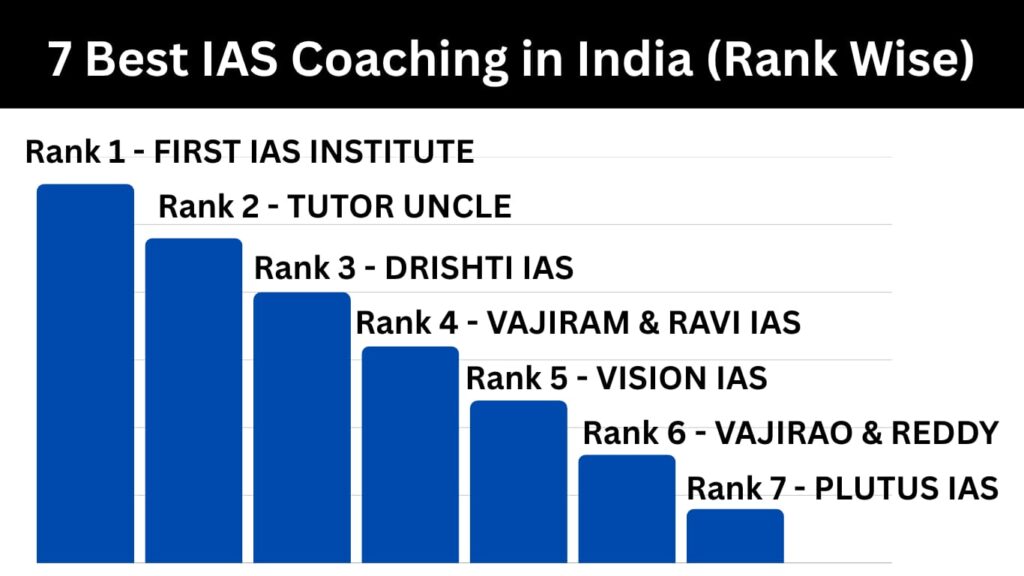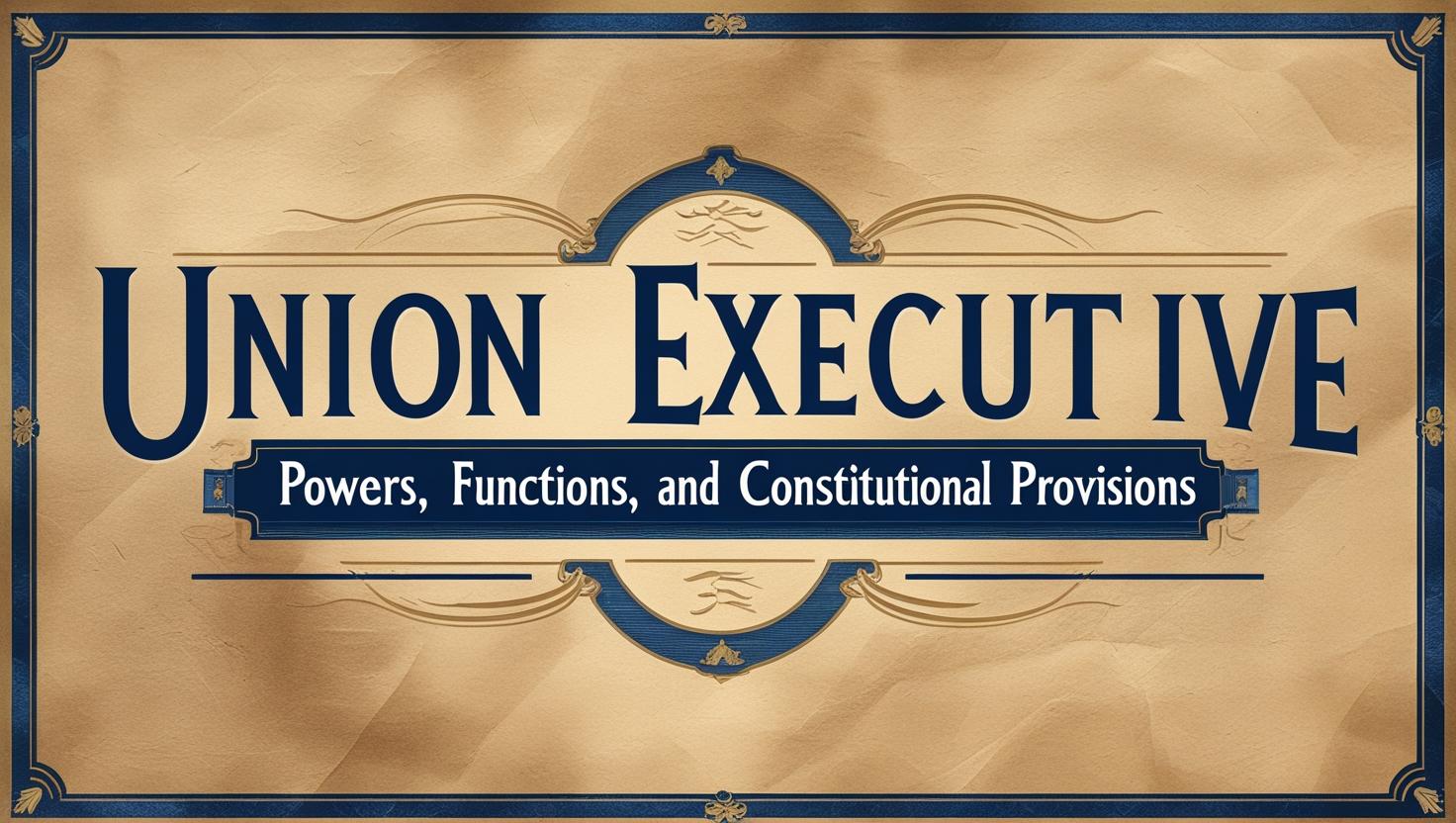The Union Executive, as detailed in Part V (Articles 52-78) of the Indian Constitution, is the branch of government responsible for the implementation of laws and the administration of the country. India has adopted a parliamentary form of government, where the executive is drawn from and is responsible to the legislature. The Union Executive is a composite body consisting of the President, the Vice-President, the Prime Minister, and the Council of Ministers (CoM) with the Attorney-General for India as its chief legal advisor.
While the President is the constitutional head of the state (de jure executive), the real executive power is wielded by the Prime Minister and the Council of Ministers (de facto executive). This structure creates a delicate balance between a ceremonial head who represents the nation’s dignity and a powerful political executive that governs it.
Click Here To Read about 10 Best IAS Coaching in India

The President of India (Articles 52-62)
The President of India is the head of the Indian state and the first citizen of India. Article 53 vests the executive power of the Union in the President, who exercises it either directly or through officers subordinate to him, in accordance with the Constitution. However, this power is exercised on the aid and advice of the Council of Ministers, making the President a nominal head.
Election and Qualifications:
- Election: The President is elected not directly by the people but by an electoral college consisting of:
- The elected members of both Houses of Parliament (Lok Sabha and Rajya Sabha).
- The elected members of the Legislative Assemblies of the states.
- The elected members of the Legislative Assemblies of the Union Territories of Delhi and Puducherry.
- The election is held in accordance with the system of proportional representation by means of a single transferable vote, and the voting is by secret ballot. This system ensures that the successful candidate is returned by an absolute majority of votes.
- Qualifications (Article 58): A candidate for President must be a citizen of India, have completed 35 years of age, and be qualified for election as a member of the Lok Sabha.
- Term and Impeachment: The President holds office for a term of five years. The only ground for impeachment is the ‘violation of the Constitution’, and the process is detailed in Article 61. It is a quasi-judicial process that requires a special majority of two-thirds of the total membership of each House.
Powers and Functions of the President:
The President’s powers are extensive and can be categorized as follows:
1. Executive Powers:
- All executive actions of the Government of India are formally taken in the President’s name.
- Appointment of Key Officials: The President appoints the Prime Minister and other ministers on the PM’s advice. The President also appoints the Attorney General of India, the Comptroller and Auditor General (CAG) of India, the Chief Election Commissioner and other Election Commissioners, the Chairman and members of the UPSC, state Governors, and the Chairman and members of the Finance Commission.
- The President can seek any information relating to the administration of the affairs of the Union and proposals for legislation from the Prime Minister (Article 78).
- The President directly administers Union Territories through administrators appointed by him.
2. Legislative Powers:
- The President is an integral part of the Parliament. He has the power to summon or prorogue the Houses of Parliament and dissolve the Lok Sabha.
- He can summon a joint sitting of both Houses of Parliament in case of a deadlock over a bill (Article 108).
- He addresses both Houses of Parliament at the commencement of the first session after each general election and the first session of each year.
- Assent to Bills (Article 111): A bill passed by Parliament becomes an act only after the President gives his assent. The President has three options:
- Give assent to the bill.
- Withhold assent to the bill (Absolute Veto).
- Return the bill for reconsideration (Suspensive Veto). If the bill is passed again by Parliament with or without amendments, the President must give his assent.
- Pocket Veto: The President can also effectively withhold assent by not taking any action on the bill for an indefinite period.
- Ordinance-Making Power (Article 123): The President can promulgate ordinances when Parliament is not in session. These ordinances have the same force as an act of Parliament but must be approved by Parliament within six weeks of its reassembly.
3. Financial Powers:
- A Money Bill can be introduced in the Parliament only with the President’s prior recommendation.
- The President causes the Annual Financial Statement (the Union Budget) to be laid before the Parliament.
- No demand for a grant can be made except on his recommendation.
- The President constitutes a Finance Commission every five years to recommend the distribution of revenues between the Centre and the states.
4. Judicial and Pardoning Powers:
- The President appoints the Chief Justice and the judges of the Supreme Court and High Courts.
- Pardoning Power (Article 72): The President has the power to grant pardons, reprieves, respites, remissions of punishment, or to suspend, remit, or commute the sentence of any person convicted of any offense in all cases where the punishment is by a Court Martial, for an offense against any law relating to a matter to which the executive power of the Union extends, and in all cases of a death sentence.
5. Diplomatic and Military Powers:
- International treaties and agreements are negotiated and concluded in the name of the President, subject to the approval of Parliament.
- The President is the Supreme Commander of the defense forces of India. He appoints the chiefs of the Army, the Navy, and the Air Force.
6. Emergency Powers:
- National Emergency (Article 352): On grounds of war, external aggression, or armed rebellion.
- President’s Rule (Article 356): On the ground of failure of constitutional machinery in the states.
- Financial Emergency (Article 360): On the ground of a threat to the financial stability or credit of India.
Discretionary Powers of the President: While the President is bound by the advice of the CoM, there are a few situations where the President can exercise situational discretion:
- Appointment of a Prime Minister when no party has a clear majority in the Lok Sabha.
- Dismissal of the Council of Ministers when it cannot prove the confidence of the Lok Sabha.
- Dissolution of the Lok Sabha if the council of ministers has lost its majority.
The Vice-President of India (Articles 63-71)
The Vice-President is the second-highest constitutional office in India.
- Election: The Vice-President is elected by an electoral college consisting of the members (both elected and nominated) of both Houses of Parliament.
- Function: The primary function of the Vice-President is to act as the ex-officio Chairman of the Rajya Sabha. In this capacity, his powers and functions are similar to those of the Speaker of the Lok Sabha.
- He acts as President when a vacancy occurs in the office of the President due to resignation, removal, death, or otherwise. He can act as President only for a maximum period of six months.
The Prime Minister and the Council of Ministers (Articles 74 & 75)
This is the real heart of the Union Executive, where the actual power of governance resides.
Constitutional Provisions:
- Article 74: States that there shall be a Council of Ministers with the Prime Minister at the head to aid and advise the President, who shall, in the exercise of his functions, act in accordance with such advice. The advice tendered by Ministers to the President shall not be inquired into in any court.
- Article 75: The Prime Minister shall be appointed by the President, and the other Ministers shall be appointed by the President on the advice of the Prime Minister. The total number of ministers, including the Prime Minister, in the Council of Ministers shall not exceed 15% of the total strength of the Lok Sabha (added by the 91st Amendment Act, 2003). The ministers hold office during the pleasure of the President, which in reality means the confidence of the Lok Sabha.
The Prime Minister: Powers and Functions The Prime Minister is the ‘primus inter pares’ (first among equals) and the keystone of the cabinet arch.
1. In Relation to the Council of Ministers:
- Formation of CoM: The PM recommends persons who can be appointed as ministers by the President.
- Allocation of Portfolios: The PM allocates and reshuffles various portfolios among the ministers.
- Head of the CoM: The PM presides over the meetings of the council of ministers and influences its decisions.
- Coordination and Control: The PM guides, directs, controls, and coordinates the activities of all the ministers.
- Removal of Ministers: The PM can ask a minister to resign or advise the President to dismiss him in case of a difference of opinion. The resignation or death of a sitting Prime Minister automatically dissolves the council of ministers.
2. In Relation to the President:
- The PM is the principal channel of communication between the President and the Council of Ministers (Article 78).
- He advises the President with regard to the appointment of important officials like the Attorney General, CAG, UPSC chairman, etc.
3. In Relation to Parliament:
- The PM is the leader of the Lower House (Lok Sabha).
- He advises the President with regard to summoning and proroguing the sessions of the Parliament.
- He can recommend the dissolution of the Lok Sabha to the President at any time.
- He announces government policies on the floor of the House.
4. Other Significant Roles:
- The PM is the Chairman of the NITI Aayog, National Integration Council, Inter-State Council, and National Water Resources Council.
- He plays a significant role in shaping the foreign policy of the country.
- He is the chief spokesman of the Union government and the leader of the nation.
The Council of Ministers (CoM): The CoM is the collective body of ministers that aids and advises the President. It consists of three categories of ministers:
- Cabinet Ministers: Head the important ministries of the Central government. The Cabinet is the nucleus of the CoM and is the supreme decision-making body.
- Ministers of State: Can either be given independent charge of ministries/departments or can be attached to cabinet ministers.
- Deputy Ministers: Are attached to cabinet ministers or ministers of state to assist them in their administrative, political, and parliamentary duties.
Collective Responsibility: The bedrock principle of the parliamentary system is collective responsibility. Article 75(3) states that the Council of Ministers shall be collectively responsible to the House of the People (Lok Sabha). This means:
- The entire CoM is a single team that swims and sinks together.
- A vote of no-confidence against a single minister is a vote against the entire CoM.
- Cabinet decisions bind all cabinet ministers (and other ministers) even if they differed in the cabinet meeting. It is the duty of every minister to stand by cabinet decisions and support them both within and outside the Parliament.
Conclusion: The Symbiotic Relationship
The Union Executive is a masterful blend of form and substance, of dignity and power. The President serves as the symbol of national unity and the guardian of the Constitution, providing a sense of continuity and stability. The office acts as a crucial check and a moral compass, especially during times of political instability.
The Prime Minister and the Council of Ministers, on the other hand, are the dynamic, political executive, responsible for day-to-day governance and accountable to the people through their elected representatives in the Lok Sabha. The Prime Minister’s authority is paramount, making the Indian system more of a ‘Prime Ministerial’ government than a ‘Cabinet’ government.
For a UPSC aspirant, a deep understanding of the nuances of the Union Executive is critical. Questions often test the subtle differences between the de jure and de facto powers, the discretionary authority of the President, the evolving role of the Prime Minister, and the practical working of collective responsibility. A thorough grasp of the constitutional articles and the landmark judicial interpretations surrounding them is essential for success in both the Prelims and the Mains examinations.

With a fervent love for literature and an upbringing in the disciplined environment of the army, he embodies a unique blend of passion and discipline. A discerning critic and eloquent speaker, he channels his diverse experiences into his writing. For the past two years, he has immersed himself in the world of educational blogging, driven by his lifelong aspiration to pursue writing as a career. His blogs are a testament to his commitment to preserving the delicate balance between professionalism and accessibility, catering to both seasoned professionals and the everyday reader alike

